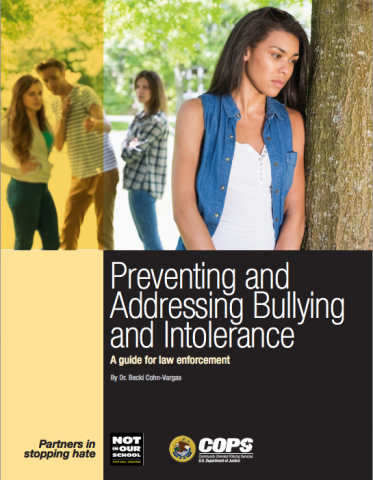By Becki Cohn-Vargas
The films and resources below are designed for school resource officers and educators working to make their schools safer, improve “identity safety,” and avoid the school to prison pipeline that is trapping so many young people.
As debate about the role of law enforcement in schools continues, Not In Our Town and Not In Our School, in partnership with the Department of Justice COPS Office, offer a new film, guides, and an article about how school resource officers can work to support students and keep them out of the criminal justice system.
Beyond the Badge: Profile of a School Resource Officer
Stay tuned for NIOT’s new film “Beyond the Badge,” which highlights the positive role a School Resource Officer can have within schools. In the midst of turmoil and division between law enforcement and the community near Ferguson, MO, St. Louis County School Resource Officer Ronald Cockrell works to bridge the gap between students and police officers. This 17 minute film follows Officer Cockrell during a school day at Central Middle School in Riverview Gardens, six months after the police shooting and protests that left North St. Louis County reeling. The story focuses on Cockrell’s efforts to build relationships, listen to students address fear of the police in a school town hall, and mentor young people on how to deal with conflict. The film, which includes a discussion guide, will be released soon, and will be available for free for community and law enforcement screenings.
Help Your SRO Become Part of Bullying Prevention efforts
NIOT is proud to join the DOJ COPS office in releasing this guide to help law enforcement officers and agencies address intolerance and prevent bullying.

This guide is intended to be a primary resource for law enforcement officers who play a large role in helping to educate and support children and adults about the problems resulting from bullying, teasing, and all forms of bias; ways to prevent and intervene in bullying situations; and how to break cycles of bullying and transform student behavior. Also featured are anecdotes from the Not In Our School campaign, an ongoing commitment to empower students to create safe and inclusive environments. The background information and strategies presented apply to young people from all ethnic groups, genders, and ages, from preschool to high school.
To download this guide for free as a PDF, please click here.
How SRO’s Can Divert Students from the Justice System
By John Rosiak
Prevention Partnerships Principal, Rosiak Associates, LLC
School Resource Officers (SRO) have been criticized in some reports for being responsible for increases in arrests in schools. Associations have been made between the presence of school-based law enforcement, increased student arrests, and referrals to juvenile court for school discipline issues—often for public order offenses, such as willful defiance, disorderly conduct, or disrupting the educational process. While there have been some instances of increased arrests in schools in the United States, other school-community partnerships are seeing opposite results—SROs helping to divert students from involvement with the justice system.
In communities around the United States, school and community groups are engaged in an important discussion about the appropriate roles of law enforcement in school safety—asking tough questions, like "Does the presence of police in schools mean:
- reduced crime?
- increased safety?
- increased arrests?
- disproportionately arresting students of color?
- making schools feel less safe?"
Many communities find that SROs—one of the best known forms of school-based law enforcement—can help make schools safer. But if schools and law enforcement agencies do not make sure that SROs are well chosen and well trained, the presence of an officer in school can encourage a criminal justice response to misconduct that would otherwise be better addressed by school administrators.
This article was originally published in the May 2015 COPS Community Policing Dispatch e-Newsletter.